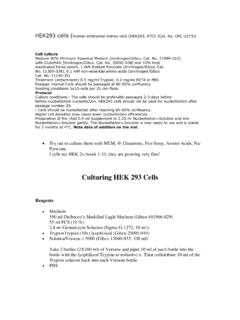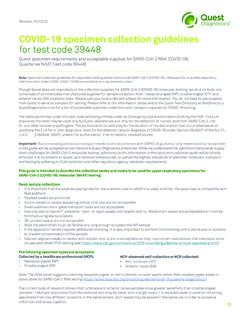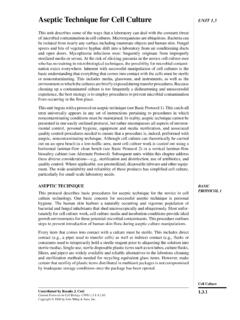Transcription of DIY LAMINAR FLOW HOOD PLANS - FreshCap Mushrooms
1 DIY LAMINAR FLOW hood PLANS PG 1 DIY LAMINAR FLOW hood PLANS DIY LAMINAR FLOW hood PLANS PG 2 This document outlines the build PLANS for a 2 x 4 LAMINAR Flow hood , including required materials and tools, as well as a step by step guide to assembling the cabinet. For this build, I used a 24 x 48 Astrocel 1 Filter and a Dayton 1 TDU2. For instructions on how we specified this filter/fan combination, be sure to check out our YouTube video DIY Flow hood Part 1: Design. If you are using your own filter/fan combinations, you can still use this as a guide for how to construct your box, just adjust the dimensions to what will work for your fan and filter.
2 NOTE: I did my best to ensure that everything in these build PLANS is as accurate as pos-sible- but be sure to use your own discretion when building your cabinet. If you see any errors, or ways to improve these build PLANS , be sure to let me know! Also, use caution when wiring your fan. Incorrect wiring could be dangerous. If you are uncomfortable wiring up your fan, please consult with an electrician. I am not an elec-trician, so even though I wired up the fan as described in the wiring diagram, I assume no liability for these wiring instructions. So, you wanna build a flow hood ? DIY LAMINAR FLOW hood PLANS PG 3 MATERIALS AND TOOLS FILTER AND FAN HEPA Filter (1) AstroCel 1 HEPA Filter 24 x 48 x 5-7/8 , Particle Board Frame, Efficient @ micrometer.
3 Blower Fan (1) Dayton 1 TDU2 Squirrel Cage Blower Fan (1202 CFM 1390 RPM) Pre-Filter (1) 16 x 25 x 1 Filtrete Furnace Filter CONSTRUCTION MATERIALS (2) Sheets 4 x 8 x Plywood (any plywood will do, smooth plywood like Shop Birch is best) (1) 2 x 3 x 8 ft lg (could also use standard 2 x 4 ) (1) Box 1-5/8 wood screws (2) Carriage Bolts (1) Tube Wood Glue (1) Tube Clear Silicone (3) ft length of door frame Weather Stripping ELECTRICAL (1) 14 Gauge Extension Cord and about 1 ft of armored cable (1) Utility Box, utility box cover, toggle switch (1) electrical tape, marrettes SUGGESTED TOOLS Circular Saw with Guide or Table Saw for cutting plywood Power Drill, bit set for pre-drilling holes Jig Saw for fan outlet hole Clamps for holding box during construction Caulking gun, sand paper or power sander Measuring tape, square, pencil, utility knife DIY LAMINAR FLOW hood PLANS PG 4 BUILDING A FLOW hood STEP BY STEP Building this LAMINAR flow hood can be broken down into 5 basic steps: 1.
4 Constructing the filter housing and plenum. 2. Installing the fan. 3. Constructing the top box for the prefilter. 4. Wiring the fan and switch. 5. Installing filter and sealing box. 1. CONSTRUCTING THE FILTER HOUSING The filter housing is the main structure of the flow hood . It holds the filter in place, and provides a plenum or air space behind the filter to build pressure and help with LAMINAR flow. It needs to be solidly built, and provides the strength to hold a large blower fan and withstand vibration. This flow hood is built using 3/4 thick shop birch , which provides a finished and clean look.
5 You may have to seek this out from a specialty wood supplier. You can also use sanded plywood, which is commonly available at Home Depot and similar retailers, although it is more expensive. Another much cheaper option is standard plywood, although this will have a rough finish. DIY LAMINAR FLOW hood PLANS PG 5 The top and bottom pieces should be cut at 24 x 48 . The top piece will eventually have a hole cut in for the fan. The two side pieces should be cut at x 20 . Using sanding paper or an electric sander, smooth out all the edges of the plywood.
6 A smooth edge will ensure a better fit. Step 1: Cut the 4 pieces that make up the main cabinet. These first four cuts could be cut from 1 sheet. This includes the bottom, the sides and the top. (the back will be added at the end of the build). 20" DIY LAMINAR FLOW hood PLANS PG 6 Bottom piece should have the 2 x 3 with the wide side down, placed 6-1/8 back from the front. Fasten together with 1-1/2 wood screws through the back of the plywood. Step 2: Cut the 2 x 3 in half, and fasten it to the bottom and top pieces to serve as a backing for the filter and to provide structural support.
7 Fasten the 2 x 3 to the plywood with wood screws. Top piece should have the 2 x 3 with the narrow side against the plywood, placed 6-1/8 back from the front. Fasten together with 1-1/2 wood screws through the back of the plywood. DIY LAMINAR FLOW hood PLANS PG 7 Step 3: Attach the side pieces with wood glue and inch wood screws. If you have long clamps, use them to hold the pieces in place as you are screwing it in. It is important to have the main cabinet square in order to properly fit the filter and the back piece. Step 4: Before proceeding, check to see if the filter fits.
8 It should be snug, but shouldn t be forced in. You also don t want air gaps around the filter, since that will allow for air leakage. Step 5: Cut the hole out of the top piece in order to install the fan. Mark out the correct location, drill four pilot holes, and cut it out with a jig saw. Sand the edges with sandpaper or a sanding block. Filter on this side. DIY LAMINAR FLOW hood PLANS PG 82. INSTALLING THE FAN The Dayton 1 TDU2 does not have a mounting flange, and does not come with mounting hardware. How-ever, it is pretty easy to use plywood, weather stripping, carriage bolts, and a 1/4 plywood shim to solidly mount the fan.
9 Step 1: Install the weather stripping around the top hole. This is used to seal the space between the outlet of the fan and the top of the box, preventing air leakage. There are many ways that you can do this, so feel free to get creative here. Pinch the weather stripping between the top box and the 3/4 x 3/4 plywood strips. Fasten the strips to the top of the box with wood screws. Once the strips are installed, test fit the fan in the hole. It should tight, with minimal chances for air leakage. If required, you can run a bead of silicon around the edge of the strips once the fan is installed. DIY LAMINAR FLOW hood PLANS PG 9 Step 2: Mount the fan by inserting it into the hole and placing a 1/4 shim under the back of the fan for additional support.
10 You may need slighty different sized shim, so use what works to fill the gap. You could also use cardboard for this. You should also install 1/4 carriage bolts through the plywood strips on both sides of the fan. Start by drilling a hole in the middle of the plywood strip, right through the outlet of the fan. Tighten the bolt, but do not overtighten, as the plywood strips have a chance of cracking. These bolts help to further support the fan, and ensure a solid installation. DIY LAMINAR FLOW hood PLANS PG 102. CONSTRUCTING THE PRE-FILTER BOX The purpose of the pre-filter is to remove the larger particles, dust, and contaminates in the air, and will extend the life of your more expensive HEPA filter.






